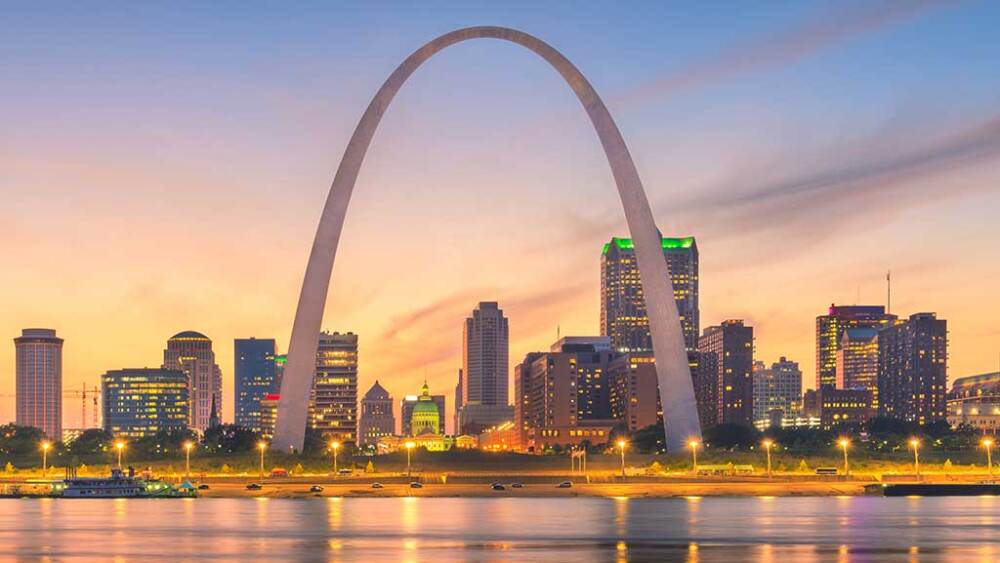A panel of real estate experts convened by the Urban Land Institute (ULI) offered dozens of recommendations to create a more vibrant, active, and inclusive Downtown St. Louis by transforming the historic Gateway Mall, which are outlined in a new report.
The recommendations are the product of a panel of urban planning and real estate experts from St. Louis and across the country convened by ULI’s Advisory Services program and ULI St. Louis. Sponsored by Greater St. Louis Inc. (GSL) and the St. Louis Development Corporation (SLDC), the panel of ULI members was tasked with prioritizing actions and policy changes to reignite activity around the Gateway Mall—specifically, the blocks between North Broadway and 11th Street and the downtown blocks immediately surrounding the park, a core centerpiece of downtown—and strengthen connections between the space and adjacent properties, catalyzing investment and economic growth.
Over several days in January, the panel held in-depth interviews with nearly 100 local stakeholders, deliberated on potential courses of action, and presented its preliminary findings to the public. The comprehensive report released today outlines short- and long-term strategic recommendations for leveraging the city’s existing physical assets, identifying opportunities for financial incentives, and implementing public policy reforms that promote the economic and social health of downtown, building upon existing plans for the area.
Top recommendations include:
Shift downtown from a single-use district to a Central Social District.
- Position culture, creativity, and diversity as key drivers of economic competitiveness.
- Foster community by investing in civic life and social infrastructure.
- Cultivate a diverse mix of uses that include art, music, fashion, and other forms of creative expression.
Curate a downtown cultural economy.
- Grow capacity for entrepreneurs and culture-makers already embedded in neighborhoods—focusing on BIPOC leaders—who will be key tenants and attractors in the downtown core.
- Create opportunities for cultural producers to build wealth from the value they bring downtown.
- Center narratives of BIPOC innovators and culture-makers around a communication strategy, positioning downtown as a place where Black and brown communities thrive.
Prioritize placemaking, placekeeping, and activation.
- Leverage space within the Gateway Mall and nearby buildings as a testing ground for creative ideas and cultural expressions.
- Implement temporary but consistent activations to revitalize weak market locations.
- Develop amenities into strong anchors for attracting residents, visitors, and businesses.
- Work with the community to consider a new name for the Gateway Mall that better matches its current and future identity.
Create and capture value by controlling more of the environment.
- Take advantage of the weak market to make strategic real estate acquisitions around the Gateway Mall.
- Hold assets and allow diverse entrepreneurs, organizations, and cultural producers to utilize these spaces and benefit financially through equity participation.
Choreograph the urban experience through a strong district manager.
- Establish a strong steward for the district with the resources and responsibility for managing both the public realm and the private-sector tenant mix.
- Explore a range of public, earned income, and private/value capture funding sources to support operations, infrastructure, and development.
“St Louis has all the ingredients for success, including a history of innovation, vibrant culture, and a high quality of life—it’s time to apply these strengths to downtown and the Gateway Mall,” said panel chair James Lima, president of James Lima Planning + Development in New York. “This panel effort has shown us how diverse stakeholders—including residents, community groups, civic organizations, and institutions such as ULI—all play key roles in supporting downtown’s transformation. The Gateway Mall can become the city’s family room, a place that welcomes everyone and positions culture, creativity, and joy as drivers of economic competitiveness.”
“Activating the Gateway Mall as Downtown St. Louis’ Central Social District will bring Downtown together and establish a hub for culture, creativity, and joy,” said Kurt Weigle, chief downtown officer for GSL. “We want to thank ULI for bringing to St. Louis the type of national thought leaders who are, in collaboration with local leaders on the ground, helping us expand upon our work to revitalize this critical downtown asset.”
“We appreciate ULI assembling a panel of industry experts and the national perspectives they brought to the process,” said Neal Richardson, president of SLDC. “Community collaboration is central to our redevelopment approach in St. Louis, so we were pleased to complement the panel with local business owners and Downtown stakeholders whose partnership will be instrumental in activating ULI’s recommendations.”
Following the conclusion of the panel, St. Louis Mayor Tishaura Jones issued a challenge to GSL and SLDC to develop plans for two properties holding back downtown—the Railway Exchange Building and the Millennium Hotel—within the next 120 days. In conjunction with the challenge, all parties formed a formal alliance to address downtown via a public-private partnership that will focus on accelerating the work needed to revitalize the heart of the metro.
The full report detailing the panel’s recommendations can be found here.
This ASP builds on the increasing body of ULI-led technical assistance focused on the future of downtowns, with similar projects completed in Cincinnati, Chicago, San Francisco, Detroit, and Pittsburgh. Additional ULI ASP reports and recommendations can be viewed here.





